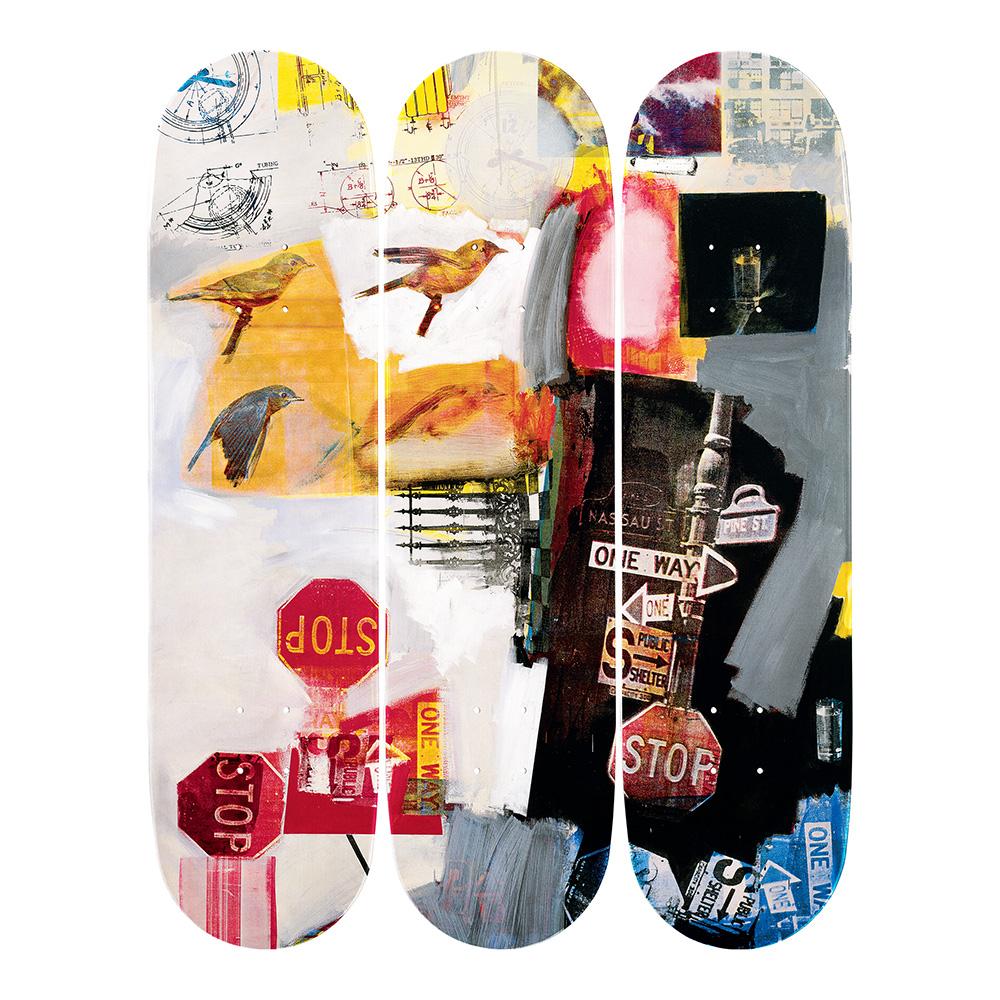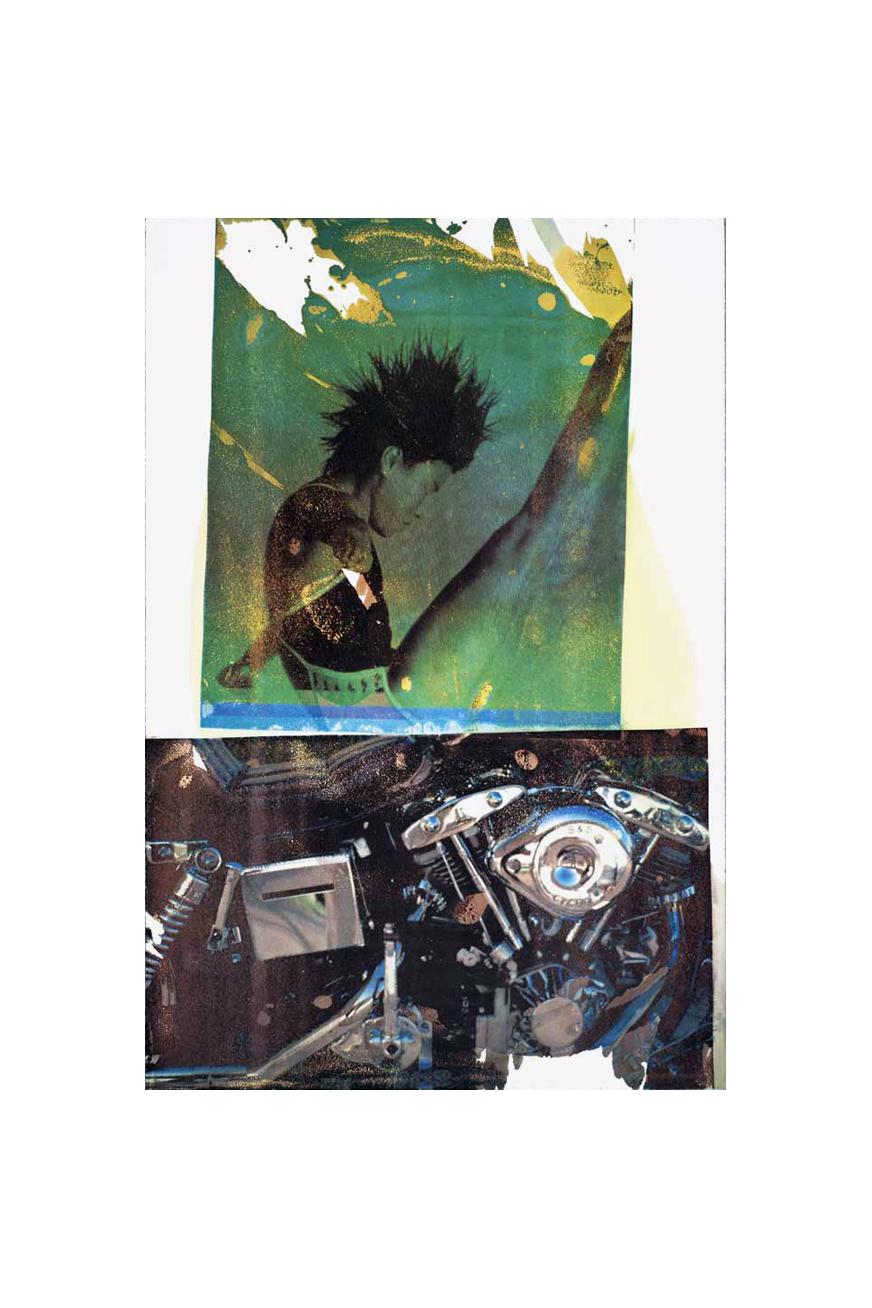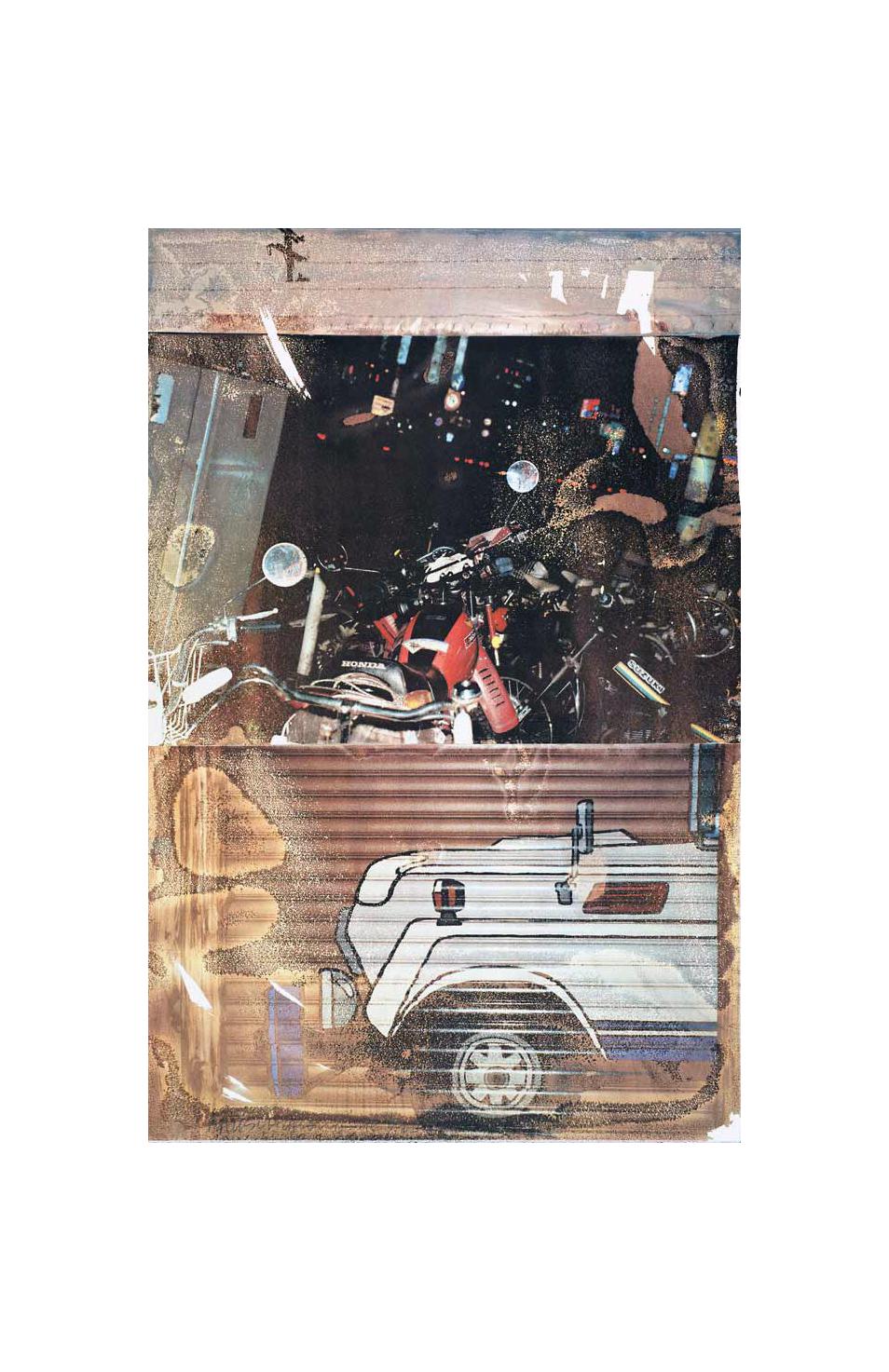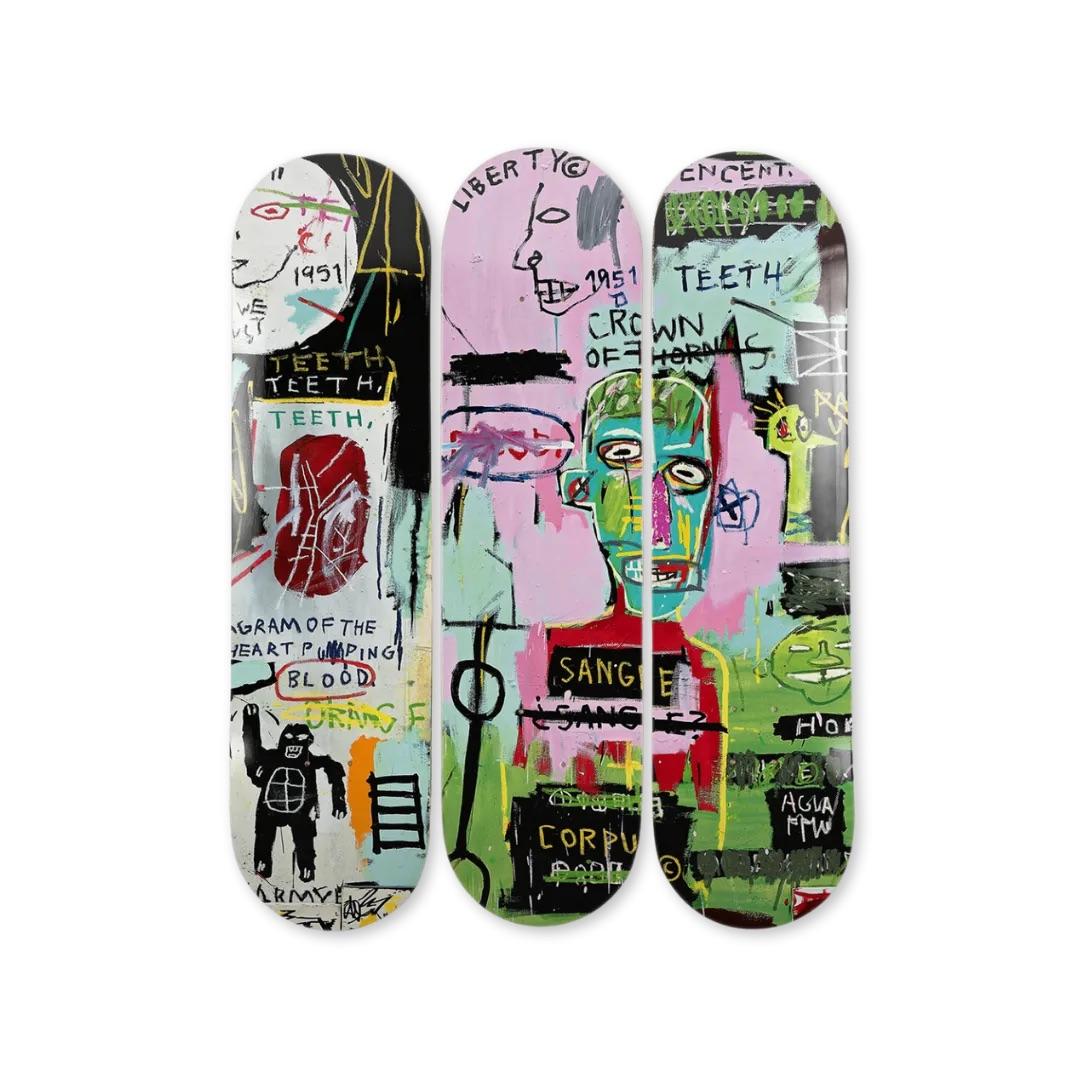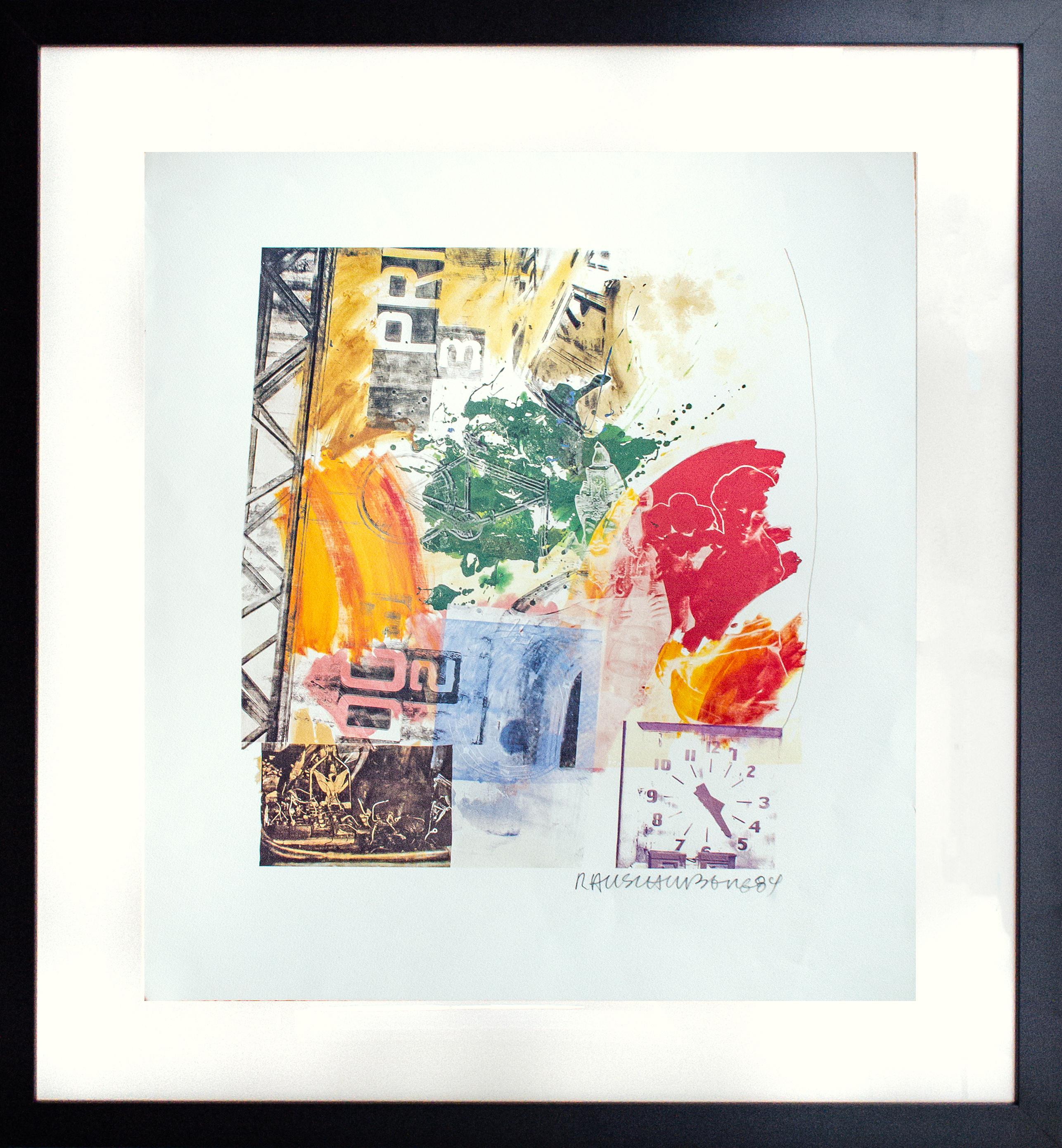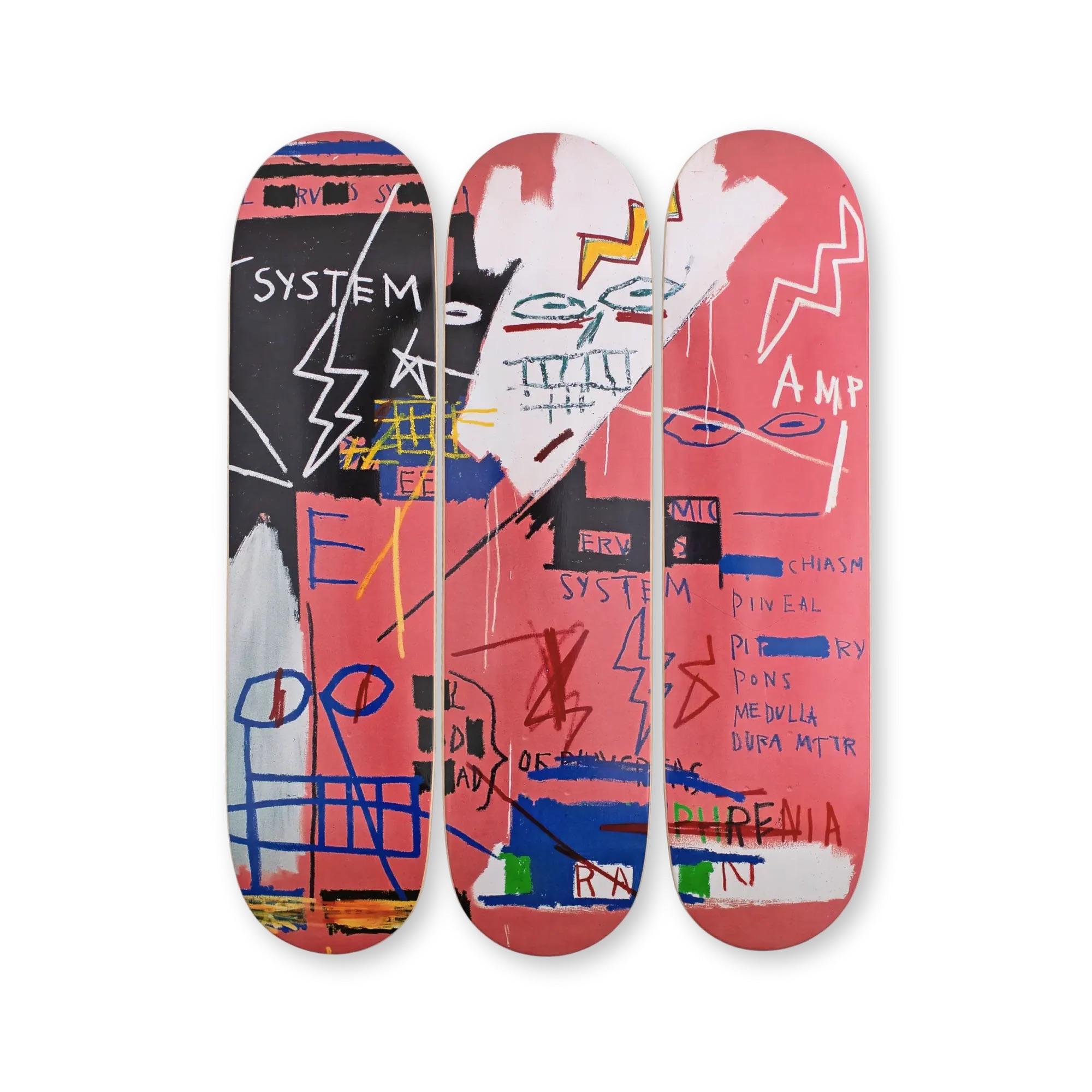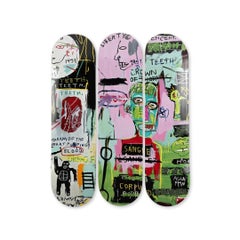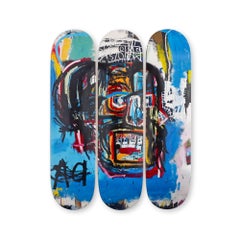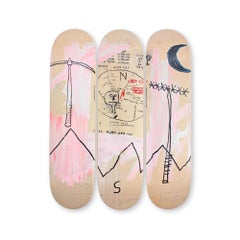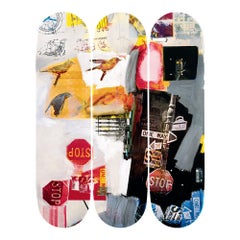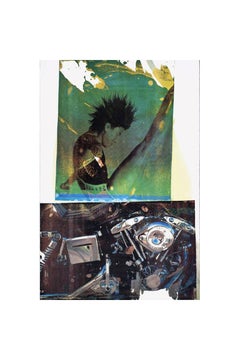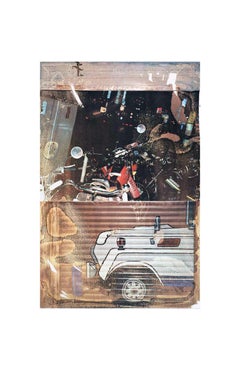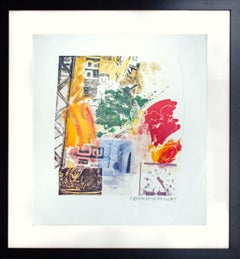Items Similar to Robert Rauschenberg - OVERDRIVE. Limited Skate Deck Modern Design Pop American
Want more images or videos?
Request additional images or videos from the seller
1 of 3
Robert Rauschenberg - OVERDRIVE. Limited Skate Deck Modern Design Pop American2017
2017
$1,124.72
£840.96
€950
CA$1,575.14
A$1,731.68
CHF 895.13
MX$20,720.69
NOK 11,300.86
SEK 10,594.87
DKK 7,237.03
About the Item
Robert Rauschenberg - OVERDRIVE
Date of creation: 2017
Medium: Digital print on Canadian maple wood
Edition: 300
Size: 80 x 20 cm (each skate)
Condition: In mint conditions and never displayed
This triptych is formed by three skate decks made of 7 ply grade A Canadian maple wood and belongs to a limited to an edition of 300.
ABOUT THE ARTIST
Robert Rauschenberg was an American artist who is widely recognized as one of the most important figures in the development of contemporary art in the 20th century. Born on October 22, 1925 in Port Arthur, Texas, Rauschenberg's early years were spent in a working-class family with limited means. Despite this, he showed an early talent for art and was encouraged by his mother to pursue his passion.
After serving in the U.S. Navy during World War II, Rauschenberg attended the Kansas City Art Institute and the Académie Julian in Paris, where he was exposed to the work of the European avant-garde. He later studied at Black Mountain College in North Carolina, where he came into contact with artists such as John Cage, Merce Cunningham, and Willem de Kooning, all of whom had a profound influence on his artistic development.
In the 1950s, Rauschenberg emerged as a leading figure in the emerging movement of Abstract Expressionism, which sought to break away from the traditional conventions of representational art. His "Combines" series, which he began in 1954, marked a departure from pure abstraction and combined elements of painting, sculpture, and found objects. This approach challenged the boundaries of what art could be and paved the way for the development of Pop Art and other avant-garde movements that followed.
Throughout his career, Rauschenberg continued to push the boundaries of traditional art forms, incorporating new media and techniques into his work. He was known for his use of non-traditional materials, such as newspaper clippings, photographs, and other found objects, as well as his experiments with silkscreen printing and digital imaging.
In addition to his innovative approach to art, Rauschenberg was also a prominent activist and philanthropist. He was a vocal advocate for human rights and social justice, and his work often addressed issues such as racism, poverty, and environmentalism. He also established the Rauschenberg Foundation, which provides grants and support to artists and organizations working in a wide range of fields.
Rauschenberg's work has been exhibited in museums and galleries around the world, and he received numerous awards and honors throughout his career, including the National Medal of Arts in 1993. He died on May 12, 2008, at the age of 82, leaving behind a legacy of artistic innovation and social engagement that continues to inspire and influence artists today.
- Creation Year:2017
- Dimensions:Height: 31.5 in (80 cm)Width: 7.88 in (20 cm)
- Medium:
- Movement & Style:
- After:Robert Rauschenberg (1925 - 2008, American)
- Period:
- Condition:
- Gallery Location:Madrid, ES
- Reference Number:1stDibs: LU1033116600172

About the Seller
5.0
Gold Seller
Premium sellers maintaining a 4.3+ rating and 24-hour response times
Established in 2011
1stDibs seller since 2018
181 sales on 1stDibs
Typical response time: 14 hours
- ShippingRetrieving quote...Shipping from: Madrid, Spain
- Return Policy
Authenticity Guarantee
In the unlikely event there’s an issue with an item’s authenticity, contact us within 1 year for a full refund. DetailsMoney-Back Guarantee
If your item is not as described, is damaged in transit, or does not arrive, contact us within 7 days for a full refund. Details24-Hour Cancellation
You have a 24-hour grace period in which to reconsider your purchase, with no questions asked.Vetted Professional Sellers
Our world-class sellers must adhere to strict standards for service and quality, maintaining the integrity of our listings.Price-Match Guarantee
If you find that a seller listed the same item for a lower price elsewhere, we’ll match it.Trusted Global Delivery
Our best-in-class carrier network provides specialized shipping options worldwide, including custom delivery.More From This Seller
View AllJEAN-MICHEL BASQUIAT - In Italian. Skate Decks Pop Urban Art Design
By Jean-Michel Basquiat
Located in Madrid, Madrid
Jean-Michel Basquiat - In Italian
Date of creation: 2024
Medium: Digital print on Canadian maple wood
Edition: Open
Size: 80 x 20 cm (each skate)
Condition: In mint conditions and never displayed
This triptych is formed by three skate decks made of 7 ply grade A Canadian maple wood.
© Estate of Jean-Michel Basquiat. Licensed by Artestar, New York
In Italian (1983) is one of Jean-Michel Basquiat’s iconic works, created during a peak period of his artistic career. The piece reflects his distinctive style, blending graffiti, expressive brushwork, text, and symbolism. Like many of his paintings, "In Italian" presents a powerful and chaotic composition where words, figures, and signs interact in a raw and energetic visual language.
The title, In Italian, may suggest a reference to classical European culture—especially Italian Renaissance art—while at the same time subverting it through Basquiat’s urban, Afro-Caribbean perspective. His interest in contrasting high and low culture, refined and raw, is evident in this piece. The inclusion of text, often fragmented or cryptic, was one of Basquiat’s trademarks and serves here to provoke thought rather than deliver a clear message.
In this work, Basquiat explores themes such as identity, language, cultural heritage, and the appropriation of symbols. The figure depicted—alongside the textual elements—appears almost mythological or totemic, reinforcing Basquiat’s tendency to elevate marginalized characters into powerful, almost divine figures.
The brushstrokes are urgent, the colors bold, and the composition layered. It’s as if the viewer is meant to decipher a code—a mix of history, race, rebellion, and irony. Words in different languages, especially English and Italian, appear not to clarify meaning but to complicate it, suggesting the multilingual, multicultural environment Basquiat inhabited and commented on.
In Italian is a prime example of how Basquiat merged influences from the streets of New York with art history, African-American identity, and global culture. It's a bold visual statement that challenges traditional canons and forces the viewer to reconsider what art is, who gets to create it, and which voices are heard.
ABOUT THE ARTIST
Jean-Michel Basquiat (1960-1988) was one of the most influential artists of the 20th century, famous for his ability to fuse urban culture, social criticism and art history into a unique style. Born in Brooklyn, New York, to a Haitian father and Puerto Rican mother, his life and work were shaped by his multicultural heritage, the New York art scene and the social tensions of his time. Although his career was brief, his impact on contemporary art has been lasting and significant.
Basquiat showed an interest in art from an early age. His mother, Matilde Andrades, took him to museums and encouraged him to draw. At the age of seven, a car accident left him hospitalized for a time, and it was then that his mother gave him a copy of the anatomy book Gray's Anatomy, which influenced his fascination with the human body and its visual representation.
Despite his early talent, Basquiat's family life was turbulent. His mother was hospitalized for psychiatric problems and his relationship with his father, Gerard Basquiat, was troubled. This instability contributed to Basquiat dropping out of school at age 17 to pursue his artistic career on the streets of New York.
As a teenager, Basquiat joined the New York graffiti scene under the pseudonym SAMO (an acronym for "Same Old Shit"), which he used to sign his cryptic and poetic messages on the streets of Manhattan with his friend Al Diaz. SAMO's graffiti were a mixture of philosophical and social commentary on popular culture, capitalism and religion, and soon attracted the attention of the underground art scene.
In 1980, SAMO "died" when Basquiat and Diaz decided to end their collaboration, marking the beginning of Basquiat's transition from street graffiti to art galleries.
Basquiat emerged as a talent to watch in 1980, when he participated in the group exhibition The Times Square Show, which included other emerging artists from New York's Lower East Side scene. That same year, he attracted the attention of critics and collectors who saw in his work an electrifying blend of street art and neo-expressionism, the predominant movement of the time.
In 1981, art critic René Ricard published the influential essay The Radiant Child in Artforum magazine, which positioned Basquiat as one of the most promising artists of his generation. Shortly thereafter, he met renowned artist Andy Warhol, with whom he formed a close friendship and significant artistic collaboration. This association was instrumental in catapulting his career into the world of high art.
The collaboration with Warhol was a pivotal point in Basquiat's career. The two artists, although coming from very different worlds, shared a fascination with fame and popular culture. Together, they produced a series of works that combined Warhol's pop art icons with Basquiat's raw, spontaneous style.
However, this collaboration was also a source of controversy. Many critics accused Warhol of "exploiting" Basquiat, while others saw the collaboration as a creative dialogue between two genius minds. Although the criticism was mixed, there is no doubt that the relationship between the two artists helped cement Basquiat's reputation in the art world.
Basquiat's style is a unique amalgam of influences. His work is characterized by the use of dismembered human figures, skeletons and internal organs, evoking the fragility of the body and mortality. Basquiat also used symbols that alluded to African-American and African history, such as crowns, masks and references to historical figures such as Toussaint Louverture.
The use of text is another crucial aspect of his work. Words, phrases and numbers appeared in his paintings, often crossed out or overlapped, creating a sense of controlled chaos. These fragmented words provoked a non-linear reading of his works and conveyed multiple layers of meaning.
His art also reflected his concerns about racial issues, especially the place of people of African descent in Western art history and in society at large. The crowns that Basquiat often drew on his figures were a symbol of power and resistance, a way of proclaiming himself "king" in a world that had historically excluded black artists from the upper echelons of art.
In works such as The Death of Michael Stewart...
Category
2010s Pop Art More Art
Materials
Wood, Digital
JEAN-MICHEL BASQUIAT - Six Fifty. Skate Decks Pop Urban Art Design
By Jean-Michel Basquiat
Located in Madrid, Madrid
Jean-Michel Basquiat - Six Fifty
Date of creation: 2024
Medium: Digital print on Canadian maple wood
Edition: Open
Size: 80 x 20 cm (each skate)
Condition: In mint conditions and never displayed
This triptych is formed by three skate decks made of 7 ply grade A Canadian maple wood.
© Estate of Jean-Michel Basquiat. Licensed by Artestar, New York
Six Fifty (1982) powerfully distills the symbolic universe and raw energy that define Jean-Michel Basquiat’s artistic language. In this piece, the artist uses a loaded iconography—lightning bolts, bones, swords, arrows, crowns—that serves as a kind of visual alphabet through which he explores themes of identity, violence, power, and cultural heritage.
With his gestural and spontaneous style, Basquiat turns the canvas into a field of tension between chaos and control, between the urgency of the street and the depth of critical thought. Like much of his work, this piece does not seek a single interpretation but instead opens multiple layers of meaning through graphic elements that seem to arise directly from the urban subconscious.
Six Fifty is not just a visual representation—it is a visceral statement, a fragment of the noise and pulse of 1980s New York, where Basquiat emerged as a radical voice in contemporary art. His ability to combine the immediacy of graffiti with historical, anatomical, and cultural references is fully evident here.
ABOUT THE ARTIST
Jean-Michel Basquiat (1960-1988) was one of the most influential artists of the 20th century, famous for his ability to fuse urban culture, social criticism and art history into a unique style. Born in Brooklyn, New York, to a Haitian father and Puerto Rican mother, his life and work were shaped by his multicultural heritage, the New York art scene and the social tensions of his time. Although his career was brief, his impact on contemporary art has been lasting and significant.
Basquiat showed an interest in art from an early age. His mother, Matilde Andrades, took him to museums and encouraged him to draw. At the age of seven, a car accident left him hospitalized for a time, and it was then that his mother gave him a copy of the anatomy book Gray's Anatomy, which influenced his fascination with the human body and its visual representation.
Despite his early talent, Basquiat's family life was turbulent. His mother was hospitalized for psychiatric problems and his relationship with his father, Gerard Basquiat, was troubled. This instability contributed to Basquiat dropping out of school at age 17 to pursue his artistic career on the streets of New York.
As a teenager, Basquiat joined the New York graffiti scene under the pseudonym SAMO (an acronym for "Same Old Shit"), which he used to sign his cryptic and poetic messages on the streets of Manhattan with his friend Al Diaz. SAMO's graffiti were a mixture of philosophical and social commentary on popular culture, capitalism and religion, and soon attracted the attention of the underground art scene.
In 1980, SAMO "died" when Basquiat and Diaz decided to end their collaboration, marking the beginning of Basquiat's transition from street graffiti to art galleries.
Basquiat emerged as a talent to watch in 1980, when he participated in the group exhibition The Times Square Show, which included other emerging artists from New York's Lower East Side scene. That same year, he attracted the attention of critics and collectors who saw in his work an electrifying blend of street art and neo-expressionism, the predominant movement of the time.
In 1981, art critic René Ricard published the influential essay The Radiant Child in Artforum magazine, which positioned Basquiat as one of the most promising artists of his generation. Shortly thereafter, he met renowned artist Andy Warhol, with whom he formed a close friendship and significant artistic collaboration. This association was instrumental in catapulting his career into the world of high art.
The collaboration with Warhol was a pivotal point in Basquiat's career. The two artists, although coming from very different worlds, shared a fascination with fame and popular culture. Together, they produced a series of works that combined Warhol's pop art icons with Basquiat's raw, spontaneous style.
However, this collaboration was also a source of controversy. Many critics accused Warhol of "exploiting" Basquiat, while others saw the collaboration as a creative dialogue between two genius minds. Although the criticism was mixed, there is no doubt that the relationship between the two artists helped cement Basquiat's reputation in the art world.
Basquiat's style is a unique amalgam of influences. His work is characterized by the use of dismembered human figures, skeletons and internal organs, evoking the fragility of the body and mortality. Basquiat also used symbols that alluded to African-American and African history, such as crowns, masks and references to historical figures such as Toussaint Louverture.
The use of text is another crucial aspect of his work. Words, phrases and numbers appeared in his paintings, often crossed out or overlapped, creating a sense of controlled chaos. These fragmented words provoked a non-linear reading of his works and conveyed multiple layers of meaning.
His art also reflected his concerns about racial issues, especially the place of people of African descent in Western art history and in society at large. The crowns that Basquiat often drew on his figures were a symbol of power and resistance, a way of proclaiming himself "king" in a world that had historically excluded black artists from the upper echelons of art.
In works such as The Death of Michael...
Category
2010s Pop Art More Art
Materials
Wood, Digital
JEAN-MICHEL BASQUIAT - Untitled Head (Skull) Skate Decks Urban Art Design
By Jean-Michel Basquiat
Located in Madrid, Madrid
Jean-Michel Basquiat - Untitled Head (Skull 2), 1982
Date of creation: 2024
Medium: Digital print on Canadian maple wood
Edition: Open
Size: 80 x 20 cm (each skate)
Condition: In mint conditions and never displayed
This triptych is formed by three skate decks made of 7 ply grade A Canadian maple wood.
© Estate of Jean-Michel Basquiat. Licensed by Artestar, New York
Untitled Head (Skull 2), 1982, is one of Jean-Michel Basquiat’s most iconic and enigmatic works, reflecting the artist’s complex relationship with life, death, and identity. Created during an early but intense phase of his career, this piece is characterized by its raw, expressive style, but also by its ability to convey a deep and multifaceted message.
The painting depicts a large skull, both grotesque and vibrant. The outlines of the skull are simple yet powerful, with angular strokes and dramatic lines. Basquiat uses a contrasting color palette, dominated by warm, earthy tones such as red, orange, and yellow, along with touches of blue and white. The skull seems to overflow with energy, full of marks and textures that evoke a sense of violence and chaos.
The skull is not only a symbol of death, but also carries connotations of internal struggle and personal suffering. Basquiat, known for his personal history marked by adversity, uses the figure of the skull to explore themes such as the fragility of life and the dehumanization of people, especially in African American communities. In his work, death is not presented merely as an abstract concept, but as something very real and close, connected to the everyday experience of those facing violence, racism, and poverty.
Through this piece, Basquiat also addresses identity and alienation, as the skull, with its exaggerated and distorted features, can be seen as a representation of an individual stripped of their humanity or cultural identity, particularly in the context of the experiences of Black communities in the United States. Basquiat often incorporates words, phrases, and symbols in his works that reflect his interest in cryptic messages and the deconstruction of meaning, and Untitled Head (Skull 2), is no exception.
The skull, often associated with mortality, in Basquiat’s context may also suggest the relentless presence of social oppression and how, in many cases, people’s lives are shaped by circumstances beyond their control. This approach to death is Basquiat’s way of engaging with the collective and personal traumas that defined his life, as well as the racial and social tensions of his time.
Untitled Head (Skull 2) is a work full of energy, with a strong symbolic charge, that breaks away from convention and offers a raw, direct view of life, death, and existential struggle. It is an example of how Basquiat used art to express his deepest emotions, challenging traditional representation and creating a piece that remains relevant today, both for its message and its unique style.
ABOUT THE ARTIST
Jean-Michel Basquiat (1960-1988) was one of the most influential artists of the 20th century, famous for his ability to fuse urban culture, social criticism and art history into a unique style. Born in Brooklyn, New York, to a Haitian father and Puerto Rican mother, his life and work were shaped by his multicultural heritage, the New York art scene and the social tensions of his time. Although his career was brief, his impact on contemporary art has been lasting and significant.
Basquiat showed an interest in art from an early age. His mother, Matilde Andrades, took him to museums and encouraged him to draw. At the age of seven, a car accident left him hospitalized for a time, and it was then that his mother gave him a copy of the anatomy book Gray's Anatomy, which influenced his fascination with the human body and its visual representation.
Despite his early talent, Basquiat's family life was turbulent. His mother was hospitalized for psychiatric problems and his relationship with his father, Gerard Basquiat, was troubled. This instability contributed to Basquiat dropping out of school at age 17 to pursue his artistic career on the streets of New York.
As a teenager, Basquiat joined the New York graffiti scene under the pseudonym SAMO (an acronym for "Same Old Shit"), which he used to sign his cryptic and poetic messages on the streets of Manhattan with his friend Al Diaz. SAMO's graffiti were a mixture of philosophical and social commentary on popular culture, capitalism and religion, and soon attracted the attention of the underground art scene.
In 1980, SAMO "died" when Basquiat and Diaz decided to end their collaboration, marking the beginning of Basquiat's transition from street graffiti to art galleries.
Basquiat emerged as a talent to watch in 1980, when he participated in the group exhibition The Times Square Show, which included other emerging artists from New York's Lower East Side scene. That same year, he attracted the attention of critics and collectors who saw in his work an electrifying blend of street art and neo-expressionism, the predominant movement of the time.
In 1981, art critic René Ricard published the influential essay The Radiant Child in Artforum magazine, which positioned Basquiat as one of the most promising artists of his generation. Shortly thereafter, he met renowned artist Andy Warhol, with whom he formed a close friendship and significant artistic collaboration. This association was instrumental in catapulting his career into the world of high art.
The collaboration with Warhol was a pivotal point in Basquiat's career. The two artists, although coming from very different worlds, shared a fascination with fame and popular culture. Together, they produced a series of works that combined Warhol's pop art icons with Basquiat's raw, spontaneous style.
However, this collaboration was also a source of controversy. Many critics accused Warhol of "exploiting" Basquiat, while others saw the collaboration as a creative dialogue between two genius minds. Although the criticism was mixed, there is no doubt that the relationship between the two artists helped cement Basquiat's reputation in the art world.
Basquiat's style is a unique amalgam of influences. His work is characterized by the use of dismembered human figures, skeletons and internal organs, evoking the fragility of the body and mortality. Basquiat also used symbols that alluded to African-American and African history, such as crowns, masks and references to historical figures such as Toussaint Louverture.
The use of text is another crucial aspect of his work. Words, phrases and numbers appeared in his paintings, often crossed out or overlapped, creating a sense of controlled chaos. These fragmented words provoked a non-linear reading of his works and conveyed multiple layers of meaning.
His art also reflected his concerns about racial issues, especially the place of people of African descent in Western art history and in society at large. The crowns that Basquiat often drew on his figures were a symbol of power and resistance, a way of proclaiming himself "king" in a world that had historically excluded black artists from the upper echelons of art.
In works such as The Death of Michael...
Category
2010s Pop Art More Art
Materials
Wood, Digital
JEAN-MICHEL BASQUIAT - Both Poles. Skate Decks Pop Urban Art Design
By Jean-Michel Basquiat
Located in Madrid, Madrid
Jean-Michel Basquiat - Both Poles
Date of creation: 2024
Medium: Digital print on Canadian maple wood
Edition: Open
Size: 80 x 20 cm (each skate)
Condition: In mint conditions and never displayed
This triptych is formed by three skate decks made of 7 ply grade A Canadian maple wood.
© Estate of Jean-Michel Basquiat. Licensed by Artestar, New York
This skateboard set reproduces Both Poles (1982), an iconic work by Jean-Michel Basquiat that encapsulates the tensions running through his visual language: past and present, earth and sky, history and immediacy. The original piece, executed in acrylic, oil stick, and collage, presents a fragmented scene dominated by a symbolic mountain, a crescent moon, and charged elements such as a sickle and a post.
Here, Basquiat confronts “both poles” of his inner and outer worlds: excavation and invocation, memory and transmission. This edition brings that conceptual force into the urban language of skateboarding, becoming both a collectible object and a contemporary artistic statement.
Transposed onto the skateboard format, the work becomes a visual declaration that bridges art and street culture, while preserving the expressive and conceptual intensity of the original.
ABOUT THE ARTIST
Jean-Michel Basquiat (1960-1988) was one of the most influential artists of the 20th century, famous for his ability to fuse urban culture, social criticism and art history into a unique style. Born in Brooklyn, New York, to a Haitian father and Puerto Rican mother, his life and work were shaped by his multicultural heritage, the New York art scene and the social tensions of his time. Although his career was brief, his impact on contemporary art has been lasting and significant.
Basquiat showed an interest in art from an early age. His mother, Matilde Andrades, took him to museums and encouraged him to draw. At the age of seven, a car accident left him hospitalized for a time, and it was then that his mother gave him a copy of the anatomy book Gray's Anatomy, which influenced his fascination with the human body and its visual representation.
Despite his early talent, Basquiat's family life was turbulent. His mother was hospitalized for psychiatric problems and his relationship with his father, Gerard Basquiat, was troubled. This instability contributed to Basquiat dropping out of school at age 17 to pursue his artistic career on the streets of New York.
As a teenager, Basquiat joined the New York graffiti scene under the pseudonym SAMO (an acronym for "Same Old Shit"), which he used to sign his cryptic and poetic messages on the streets of Manhattan with his friend Al Diaz. SAMO's graffiti were a mixture of philosophical and social commentary on popular culture, capitalism and religion, and soon attracted the attention of the underground art scene.
In 1980, SAMO "died" when Basquiat and Diaz decided to end their collaboration, marking the beginning of Basquiat's transition from street graffiti to art galleries.
Basquiat emerged as a talent to watch in 1980, when he participated in the group exhibition The Times Square Show, which included other emerging artists from New York's Lower East Side scene. That same year, he attracted the attention of critics and collectors who saw in his work an electrifying blend of street art and neo-expressionism, the predominant movement of the time.
In 1981, art critic René Ricard published the influential essay The Radiant Child in Artforum magazine, which positioned Basquiat as one of the most promising artists of his generation. Shortly thereafter, he met renowned artist Andy Warhol, with whom he formed a close friendship and significant artistic collaboration. This association was instrumental in catapulting his career into the world of high art.
The collaboration with Warhol was a pivotal point in Basquiat's career. The two artists, although coming from very different worlds, shared a fascination with fame and popular culture. Together, they produced a series of works that combined Warhol's pop art icons with Basquiat's raw, spontaneous style.
However, this collaboration was also a source of controversy. Many critics accused Warhol of "exploiting" Basquiat, while others saw the collaboration as a creative dialogue between two genius minds. Although the criticism was mixed, there is no doubt that the relationship between the two artists helped cement Basquiat's reputation in the art world.
Basquiat's style is a unique amalgam of influences. His work is characterized by the use of dismembered human figures, skeletons and internal organs, evoking the fragility of the body and mortality. Basquiat also used symbols that alluded to African-American and African history, such as crowns, masks and references to historical figures such as Toussaint Louverture.
The use of text is another crucial aspect of his work. Words, phrases and numbers appeared in his paintings, often crossed out or overlapped, creating a sense of controlled chaos. These fragmented words provoked a non-linear reading of his works and conveyed multiple layers of meaning.
His art also reflected his concerns about racial issues, especially the place of people of African descent in Western art history and in society at large. The crowns that Basquiat often drew on his figures were a symbol of power and resistance, a way of proclaiming himself "king" in a world that had historically excluded black artists from the upper echelons of art.
In works such as The Death of Michael...
Category
2010s Pop Art More Art
Materials
Wood, Digital
JEAN-MICHEL BASQUIAT - Charles The First. Skate Decks Pop Urban Art Design
By Jean-Michel Basquiat
Located in Madrid, Madrid
Jean-Michel Basquiat - Charles The First
Date of creation: 2024
Medium: Digital print on Canadian maple wood
Edition: Open
Size: 80 x 20 cm (each skate)
Condition: In mint conditions and never displayed
This triptych is formed by three skate decks made of 7 ply grade A Canadian maple wood.
© Estate of Jean-Michel Basquiat. Licensed by Artestar, New York
This skateboard set reproduces Charles The First (1982), a key work by Jean-Michel Basquiat that pays tribute to Charlie Parker, the influential jazz saxophonist known as "Bird." Basquiat captures the frantic energy and complexity of Parker through his signature style, blending elements of Black culture, music, and the figure of the artist in a raw and powerful representation.
The original painting, executed with acrylics, oils, and pastels, presents a stylized figure that recalls both a portrait and a symbol. The face is fragmented, filled with quick strokes and vibrant colors, while the outline and details evoke both divinity and struggle. Basquiat uses his unique visual language to convey the chaos and beauty of Parker’s life, a metaphor for creativity as a form of resistance and expression.
Transposed onto the skateboard format, Charles The First becomes a dynamic work of art that not only celebrates the life of a musical icon but also merges contemporary art with urban culture. This piece transcends simple reproduction, inviting a connection between visual art and movement in the streets, with the same vigor and attitude Basquiat infused into his work.
ABOUT THE ARTIST
Jean-Michel Basquiat (1960-1988) was one of the most influential artists of the 20th century, famous for his ability to fuse urban culture, social criticism and art history into a unique style. Born in Brooklyn, New York, to a Haitian father and Puerto Rican mother, his life and work were shaped by his multicultural heritage, the New York art scene and the social tensions of his time. Although his career was brief, his impact on contemporary art has been lasting and significant.
Basquiat showed an interest in art from an early age. His mother, Matilde Andrades, took him to museums and encouraged him to draw. At the age of seven, a car accident left him hospitalized for a time, and it was then that his mother gave him a copy of the anatomy book Gray's Anatomy, which influenced his fascination with the human body and its visual representation.
Despite his early talent, Basquiat's family life was turbulent. His mother was hospitalized for psychiatric problems and his relationship with his father, Gerard Basquiat, was troubled. This instability contributed to Basquiat dropping out of school at age 17 to pursue his artistic career on the streets of New York.
As a teenager, Basquiat joined the New York graffiti scene under the pseudonym SAMO (an acronym for "Same Old Shit"), which he used to sign his cryptic and poetic messages on the streets of Manhattan with his friend Al Diaz. SAMO's graffiti were a mixture of philosophical and social commentary on popular culture, capitalism and religion, and soon attracted the attention of the underground art scene.
In 1980, SAMO "died" when Basquiat and Diaz decided to end their collaboration, marking the beginning of Basquiat's transition from street graffiti to art galleries.
Basquiat emerged as a talent to watch in 1980, when he participated in the group exhibition The Times Square Show, which included other emerging artists from New York's Lower East Side scene. That same year, he attracted the attention of critics and collectors who saw in his work an electrifying blend of street art and neo-expressionism, the predominant movement of the time.
In 1981, art critic René Ricard published the influential essay The Radiant Child in Artforum magazine, which positioned Basquiat as one of the most promising artists of his generation. Shortly thereafter, he met renowned artist Andy Warhol, with whom he formed a close friendship and significant artistic collaboration. This association was instrumental in catapulting his career into the world of high art.
The collaboration with Warhol was a pivotal point in Basquiat's career. The two artists, although coming from very different worlds, shared a fascination with fame and popular culture. Together, they produced a series of works that combined Warhol's pop art icons with Basquiat's raw, spontaneous style.
However, this collaboration was also a source of controversy. Many critics accused Warhol of "exploiting" Basquiat, while others saw the collaboration as a creative dialogue between two genius minds. Although the criticism was mixed, there is no doubt that the relationship between the two artists helped cement Basquiat's reputation in the art world.
Basquiat's style is a unique amalgam of influences. His work is characterized by the use of dismembered human figures, skeletons and internal organs, evoking the fragility of the body and mortality. Basquiat also used symbols that alluded to African-American and African history, such as crowns, masks and references to historical figures such as Toussaint Louverture.
The use of text is another crucial aspect of his work. Words, phrases and numbers appeared in his paintings, often crossed out or overlapped, creating a sense of controlled chaos. These fragmented words provoked a non-linear reading of his works and conveyed multiple layers of meaning.
His art also reflected his concerns about racial issues, especially the place of people of African descent in Western art history and in society at large. The crowns that Basquiat often drew on his figures were a symbol of power and resistance, a way of proclaiming himself "king" in a world that had historically excluded black artists from the upper echelons of art.
In works such as The Death of Michael Stewart...
Category
2010s Pop Art More Art
Materials
Wood, Digital
JEAN-MICHEL BASQUIAT - Horn Players, 1983 Skate Decks Pop Urban Art Design
By Jean-Michel Basquiat
Located in Madrid, Madrid
Jean-Michel Basquiat - Horn Players, 1983
Date of creation: 2024
Medium: Digital print on Canadian maple wood
Edition: Open
Size: 80 x 20 cm (each skate)
Condition: In mint conditions and never displayed
This triptych is formed by three skate decks made of 7 ply grade A Canadian maple wood.
© Estate of Jean-Michel Basquiat. Licensed by Artestar, New York
"Horn Players" (1983) is one of Jean-Michel Basquiat's most famous works, and a great example of his unique style, which blends graffiti, pop art, and expressionist painting. In this piece, Basquiat depicts two jazz musicians, probably inspired by legends like Charlie Parker and Dizzy Gillespie. The figures are stylized with exaggerated features, something typical of his work.
The painting is dominated by vibrant colors like yellow, red, and blue, with a background full of marks and strokes that give the sense of movement, as if you were hearing the music the characters are playing. Basquiat also incorporates text, such as the words “SAX” and “BIRD” (referring to Charlie "Bird" Parker), which not only provide more information about the characters but also add an extra layer of meaning, creating a connection between the music, the words, and the image.
The piece can be interpreted as a tribute to African American culture and its impact on music, especially jazz, which was born in that community. But it also reflects deeper themes of identity, as the musicians are not just represented physically but also symbolically, through the music and the words surrounding them. Basquiat, who often explored themes of race, power, violence, and inequality, uses this work to highlight how jazz serves as a form of expression and resistance for Black culture.
In 1983, when Basquiat created "Horn Players", he was already at the peak of his career. He had gained significant recognition in New York, and his work was widely acknowledged in the contemporary art world. This painting is part of a series where he pays homage to musicians and the history of jazz, a recurring theme in his work.
Additionally, there’s an interesting connection between Basquiat’s art and the world of skateboarding. Skateboarding, much like Basquiat’s art, is defined by its rebellious spirit, its focus on urban culture, and its drive for self-expression. Basquiat's graffiti-style brushstrokes, with their raw energy, evoke the same defiant attitude seen in skateboarding culture, where skaters, much like artists, break free from established norms and create something unique. The influence of graffiti, which is central to skateboarding’s aesthetic, is also present in Basquiat’s works, forming a natural link between these two worlds of rebellion and creativity.
"Horn Players" is a representative piece of Basquiat because it captures his vibrant style, his love for cultural references, and his ability to blend visual art with music. Moreover, it’s a work that celebrates Black culture, rebellion, and creative energy—values that also strongly resonate in the world of skateboarding. All of this showcases Basquiat’s mastery in merging different forms of artistic expression, connecting music, urban art, and the culture of resistance in a powerful work.
ABOUT THE ARTIST
Jean-Michel Basquiat (1960-1988) was one of the most influential artists of the 20th century, famous for his ability to fuse urban culture, social criticism and art history into a unique style. Born in Brooklyn, New York, to a Haitian father and Puerto Rican mother, his life and work were shaped by his multicultural heritage, the New York art scene and the social tensions of his time. Although his career was brief, his impact on contemporary art has been lasting and significant.
Basquiat showed an interest in art from an early age. His mother, Matilde Andrades, took him to museums and encouraged him to draw. At the age of seven, a car accident left him hospitalized for a time, and it was then that his mother gave him a copy of the anatomy book Gray's Anatomy, which influenced his fascination with the human body and its visual representation.
Despite his early talent, Basquiat's family life was turbulent. His mother was hospitalized for psychiatric problems and his relationship with his father, Gerard Basquiat, was troubled. This instability contributed to Basquiat dropping out of school at age 17 to pursue his artistic career on the streets of New York.
As a teenager, Basquiat joined the New York graffiti scene under the pseudonym SAMO (an acronym for "Same Old Shit"), which he used to sign his cryptic and poetic messages on the streets of Manhattan with his friend Al Diaz. SAMO's graffiti were a mixture of philosophical and social commentary on popular culture, capitalism and religion, and soon attracted the attention of the underground art scene.
In 1980, SAMO "died" when Basquiat and Diaz decided to end their collaboration, marking the beginning of Basquiat's transition from street graffiti to art galleries.
Basquiat emerged as a talent to watch in 1980, when he participated in the group exhibition The Times Square Show, which included other emerging artists from New York's Lower East Side scene. That same year, he attracted the attention of critics and collectors who saw in his work an electrifying blend of street art and neo-expressionism, the predominant movement of the time.
In 1981, art critic René Ricard published the influential essay The Radiant Child in Artforum magazine, which positioned Basquiat as one of the most promising artists of his generation. Shortly thereafter, he met renowned artist Andy Warhol, with whom he formed a close friendship and significant artistic collaboration. This association was instrumental in catapulting his career into the world of high art.
The collaboration with Warhol was a pivotal point in Basquiat's career. The two artists, although coming from very different worlds, shared a fascination with fame and popular culture. Together, they produced a series of works that combined Warhol's pop art icons with Basquiat's raw, spontaneous style.
However, this collaboration was also a source of controversy. Many critics accused Warhol of "exploiting" Basquiat, while others saw the collaboration as a creative dialogue between two genius minds. Although the criticism was mixed, there is no doubt that the relationship between the two artists helped cement Basquiat's reputation in the art world.
Basquiat's style is a unique amalgam of influences. His work is characterized by the use of dismembered human figures, skeletons and internal organs, evoking the fragility of the body and mortality. Basquiat also used symbols that alluded to African-American and African history, such as crowns, masks and references to historical figures such as Toussaint Louverture.
The use of text is another crucial aspect of his work. Words, phrases and numbers appeared in his paintings, often crossed out or overlapped, creating a sense of controlled chaos. These fragmented words provoked a non-linear reading of his works and conveyed multiple layers of meaning.
His art also reflected his concerns about racial issues, especially the place of people of African descent in Western art history and in society at large. The crowns that Basquiat often drew on his figures were a symbol of power and resistance, a way of proclaiming himself "king" in a world that had historically excluded black artists from the upper echelons of art.
In works such as The Death of Michael Stewart...
Category
2010s Pop Art More Art
Materials
Wood, Digital
You May Also Like
Overdrive
By Robert Rauschenberg
Located in New York, NY
Robert Rauschenberg, Overdrive, 2017
Screenprints in color on three individual maple wood skate decks
With artist's printed signature
31 x 8 in. (78.7 x 20.3 cm), each, unframed
Edit...
Category
21st Century and Contemporary More Art
Materials
Screen
Sports
By Robert Rauschenberg
Located in Calabasas, CA
Artist: Robert Rauschenberg
Title: Sports
Year: 1994
Medium: Lithograph with vegetable dye water transfer on Arches Infinity paper
Edition: 50; signed, dated and numbered in pencil
S...
Category
1990s Contemporary Abstract Prints
Materials
Lithograph
Technology
By Robert Rauschenberg
Located in Calabasas, CA
Artist: Robert Rauschenberg
Title: Technology
Year: 1994
Medium: Lithograph with vegetable dye water transfer on Arches Infinity paper
Edition: 50; signed, dated and numbered in penc...
Category
1990s Contemporary Abstract Prints
Materials
Lithograph
Robert Rauschenberg Signed Lithograph
By Robert Rauschenberg
Located in New York, NY
Robert Rauschenberg
American (1925-2008)
Untitled, for ROCI
offset color lithograph, signed and dated lower right "Rauschenberg 84"
25 3/4 x 22 3/4 in. (sheet)
Framed: 31 1/4 x 29 x...
Category
1980s Post-Modern Figurative Prints
Materials
Lithograph
Robert Rauschenberg 'Core'
By Robert Rauschenberg
Located in New York, NY
C.O.R.E.
1965
Lithograph
Signed and numbered edition of 200
36 X 24 inches
Robert Rauschenberg’s work reflects a methodology between the approaches of structuralism and post-...
Category
21st Century and Contemporary Pop Art Abstract Prints
Materials
Lithograph
Price Upon Request
Flaps 12-color screen print by Robert Rauschenberg Edition 36 of 52
By Robert Rauschenberg
Located in Boca Raton, FL
12-color screen print on deckle edge paper of a collage of Moroccan street scenes including an orange stand, umbrellas, a motorcycle shop and a F...
Category
Early 2000s Contemporary Landscape Prints
Materials
Screen
More Ways To Browse
Ron Adams
Rothko Signed Prints
Roy Lichtenstein Apple
Shorewood Reproductions
St Louis Symphony
Stella Frank Plates
Swan Engraving
Victor Vasarely Squares
Vintage Disease Posters
Vintage Housewife Art
Vintage Yield Sign
Violin Signed Prints
Virgilio Trompiz
Woody Pirtle
Yannis Moralis
Yannis Tsarouchis
1970 Calendar Print
Ai Weiwei Bomb
